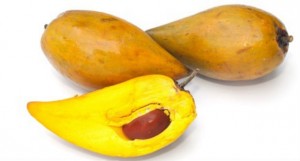Tiesa fruit now a source of natural food coloring – DOST
MANILA, Philippines – The Department of Science and Technology (DoST) has made a discovery that could make the tiesa fruit (canistel) economically viable.
The yellow tiesa, which is of little economic value because of the pasty texture of its flesh considered an acquired taste for most Filipinos, has been developed into natural food coloring by DoST food researchers.
Addressing the clamor for natural and organic-based food, the agency’s Industrial Technology Development Institute (ITDI) explored potentials of the tiesa (Pouteria campechiana), an underutilized agricultural crop.
Teresita Palomares, the supervising science research specialist and ITDI Food Processing Division officer-in-charge Teresita Palomares, said the standard process to develop the tiesa into natural food color as an alternative to the synthetic food coloring tartrazine or FD&C Yellow 5 was based on the fruit’s characteristics.
The tiesa contains fair levels of ascorbic acide, is rich in niacin and has a relatively high content of carotenoid, an organic pigment of yellow, orange or red color suitable for food application.
Palomares said, “Nowadays we cannot deny the importance of coloring materials being applied to food because of the many benefits it offers.”
She cited as benefits the coloring’s preservation of the appearance of the food even after processing and storage to make food look appetizing as well as to protect the food’s flavor and light-susceptible vitamins, which inspired the ITDI to develop natural food color from tiesa.
Research team leader and science research specialist II Christopher Andrew Bilbao said that during the development process, his group “standardized the methods of extracting and purifying the carotenoid pigments” of the tiesa.
“Various parameters during extraction and purification were investigated and optimized to achieve the most efficient process,” he said, referring to the extraction solvent, temperature and time as the parameters.
Employing solid to liquid extraction using different solvents for food use, researchers tested “appropriate carriers,” including: sunflower oil; an emulsifier mixture; the food additive maltodextrin; and modified cornstarch, for the purified pigments.
They found that the natural food coloring developed in the emulsifier mixture was most promising. When applied to calamansi juice, Bilbao said, it showed an enhanced yellow color with no immediate degradation of the color.
The research team leader suggested that other extraction techniques be studied to develop more efficient procedures in the production of natural food coloring from tiesa.
“Other sources of natural pigments should be investigated to have more sources for natural colorants,” he concluded.
